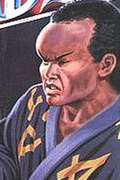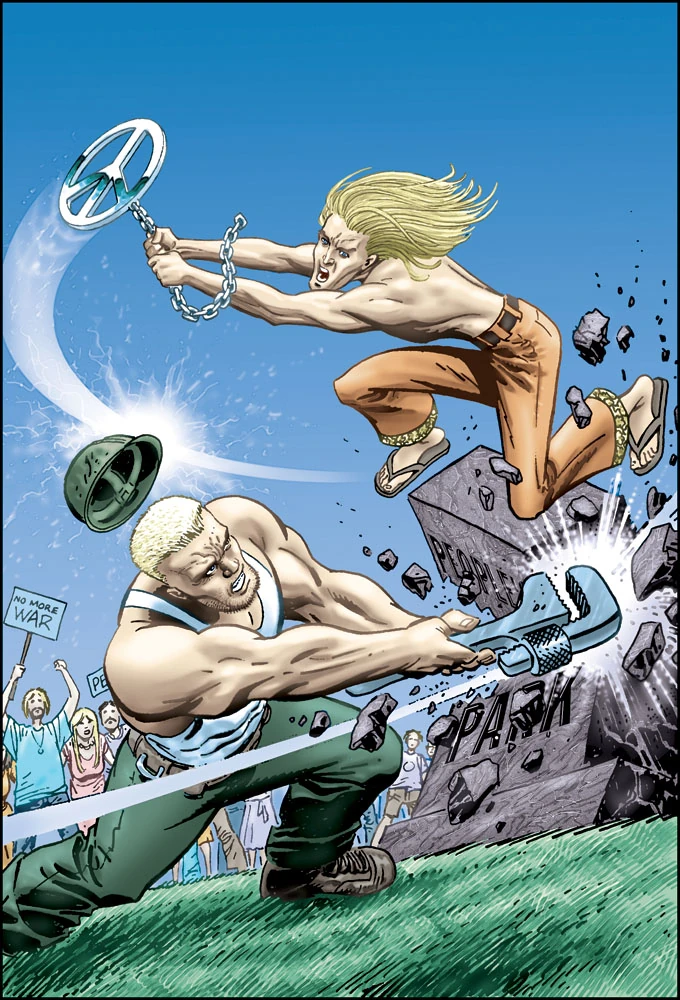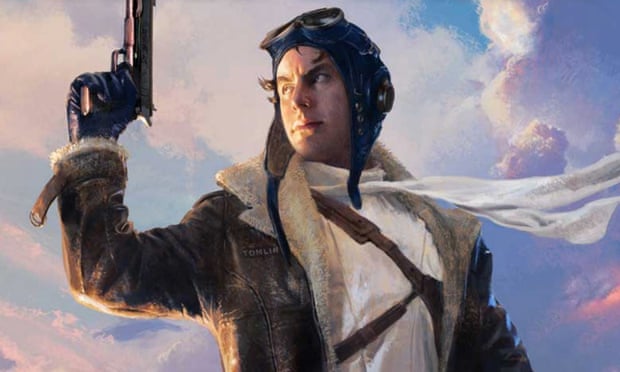 This story is probably the most violent and disturbing of the many stories in the book, primarily for one of the most uncomfortable interrogation scenes ever set to paper. However, it is actually a fascinating character study both for what it reveals about the larger universe and what it reveals about the main characters.
First, the story explores is the first to really explore the idea that the Wild Cards virus acts on the subconscious thoughts of it's hosts. Thus, the abilities and deformities it grants its hosts are based on their subconscious beliefs and fears. Fortunato is, uh, practicing a Tantric ritual when his powers emerge and, as a result, his vast powers only work when he preforms the appropriate spell.
This story is probably the most violent and disturbing of the many stories in the book, primarily for one of the most uncomfortable interrogation scenes ever set to paper. However, it is actually a fascinating character study both for what it reveals about the larger universe and what it reveals about the main characters.
First, the story explores is the first to really explore the idea that the Wild Cards virus acts on the subconscious thoughts of it's hosts. Thus, the abilities and deformities it grants its hosts are based on their subconscious beliefs and fears. Fortunato is, uh, practicing a Tantric ritual when his powers emerge and, as a result, his vast powers only work when he preforms the appropriate spell.The idea of the Wild Card begin able to grant people abilities baed on their beliefs allowed the series to bring in characters who would normally be outside its scope in a world where super-powers come from a single source. Fortunato is an uncouth analogue for mystical heroes like Dr. Strange and Dr. Fate. In later stories, the virus would allow for the creation of an android hero similar to Marvel's Vision and mythological figures who serve as Thor analogues.
Fourtunato himself is a rather complex character. Technically a "hero", simply because he sets himself in opposition to an unquestionably evil organization, he is still a criminal himself who exploits women for a living. His greatest fear is that, to quote Spider-Man, "with great power comes great responsibility." The character's constant struggle with the idea that, as much as he may deny it, he has an obligation to uses his powers to help others or, at the very least, for things other than criminal activities drives much of his actions throughout the series.
 The next story is "Transfigurations"by Victor Milan is set in the late 60 and early 70s and follows Marc Meadows, a MIT student who has become enamored with the hippy movement and is looking to enter the drug scene. The plot is pretty impossible to discuss without spoilers so SPOILER WARNING. Meadows spends most of the story awkwardly courting his old grade school crush and dithering back and forth on whether or not to take LSD for the first time. He finally takes his first dose as a fight between two aces breaks out, a fight which is then broken up by the appearance of a third ace called the Radical, who subsequently disappears. Mark wakes up the next day with vague memories of participating in the fight and begins experimenting with drugs in an attempt to determine if he was, in fact the Radical.
The next story is "Transfigurations"by Victor Milan is set in the late 60 and early 70s and follows Marc Meadows, a MIT student who has become enamored with the hippy movement and is looking to enter the drug scene. The plot is pretty impossible to discuss without spoilers so SPOILER WARNING. Meadows spends most of the story awkwardly courting his old grade school crush and dithering back and forth on whether or not to take LSD for the first time. He finally takes his first dose as a fight between two aces breaks out, a fight which is then broken up by the appearance of a third ace called the Radical, who subsequently disappears. Mark wakes up the next day with vague memories of participating in the fight and begins experimenting with drugs in an attempt to determine if he was, in fact the Radical.This story feels the most frustratingly incomplete. Give what we learn about Meadows in the next book, his quest to become the Radical is merely the beginning of his transformation into an ace. Thus, "Transfigurations" reads more the first half of an origin story and since Meadow's transformation is already complete in the second book, the reader doesn't get to see the second half. Furthermore, the story sets up a subplot about the conservative ace Hardhat and his quest for his daughter which is then completely dropped as the character never appears again. Despite this, it's impossible to hate this story as Meadows himself is the nicest character in the first part of the series and quickly endears himself to the reader.
The next interlude gives us a status update of the world in 1971. Written as a Tom Wolfe pastiche, it introduces the celebrity culture that has sprung up around the aces in the wake of the Turtle's emergence as a crimefighter. This interlude primarily serves to introduce the cult of celebrity that has grown around aces, and flesh out a location that will important in later books: celebrity restaurant Aces High, run by Hiram Worcester, formerly the Fatman, a retired hero turned restaurant owner.
The next story is "Down Deep" by Edward Bryant and Leanne C. Harper which introduces a group of sewer dwelling heroes. The main protagonists are Mafia princess and aspiring social worker Rosa-Maria Gambione, her client Bagabond, a homeless woman who can talk to animals, and "Sewer Jack" Robicheaux, a were-alligator sewer maintenance worker. When Rosa's fiancee, a member of the local mob, is murdered by the mysterious Subway Vigilante, it precipitates a gang war that draws all three protagonists to the sewers to stop the Mafia from carrying out a massacre.
This story, though better than "The Sleeper", introduced what are honestly my least favorite of the Wild Cards characters from the first book, Bagabond and Sewer Jack. They're not terrible characters by any means but they always seemed disconnected from the other characters and more like they should be part of a separate series. There are lip service mentions to characters from the previous stories but they really do not figure into the action. (Admittedly, a major character in this story had previously made a cameo earlier in the book but that was more to set up their appearance in this story then anything else.)
According to Martin, this story was written before the decision was made to set the first Wild Card outbreak in the 1940s and had to be re-edited later to fit the setting. This definitely shows in the story. A scene where Bagabond and Sewer Jack come to realize that they are both Aces makes sense in a context where the virus is a relatively recent phenomenon but not so much in a setting where Aces have been around for over twenty years. The story is not bad. I just wish it felt more like it was part of the larger series.
"Down Deep" is followed up by a story that focuses more on the true victims of the Wild Card virus: the disfigured jokers. Another interlude show establishes two revival joker advocacy groups operating out of Jokertown, a joker ghetto in New York City. One is the The Joker Anti-Defamation League, which advocates for non-violent resistance led by an elephant Joker who goes by the name of Xavier Desmond. (No points for guessing who inspired this character). Opposing him is the militant Joker's for a Just Society, led by Tom Miller aka Gimli, whose Wild Card virus has turned him into a super-strong dwarf.
This situation is then explored more thoroughly in the disturbing story "Strings" by Stephen Leigh which introduces the Wild Card's universe first major super-villain and is impossible to discuss without SPOILERS so consider yourself warned. The story starts, in the 1940s, with a brutal murder instigated by the emotion controlling ace known as Puppetman, who we soon learn is only 11 years old. The story then jumps to 1976 where the Jokers for a Just Society are threatening to riot if their demands aren't heard. The story follows Succubus, a joker prostitute, who is spying on one of her clients, pro-joker right Senator Gregg Hartman, on behalf of Gimli. There are several hints throughout the story that Puppetman is actually Gimli, but we eventually learn that Puppetman is Senator Hartman, secretly using his powers to provoke the jokers to riot as part of a bid for the Presidency. Eventually, Puppetman's powers lead to his own undoing but he escapes detection to plot again another day.
This story sets the tone for what villains are like in the Wild Cards universe. Since the heroes are themselves incredibly flawed, the villains, by contrast, are all massive psychopaths so the audience knows who to root for. This is true of this story which also includes fun little bits of world building: the Jokertown Riots of 76 will be a plot point throughout the series and the story include an action-packed team-up between several of the ace heroes which introduces several new characters. The story also adds an element of suspense as Gregg Hartman is almost universally loved by both jokers and aces, all of whom are unaware of his inner depravity.
 Unfortunately, this story highlights what can be the most maddening aspect in the Wild Cards universe. Because of the multiple writers working on each story and the needs of each book, plot threads and characters introduced in one book can be ignored for multiple books before being followed up on, if they ever are. Despite being Wild Card's first major villain, Puppetman does not appear outside of cameos for the next two books which is a shame because he turns out to be a fascinating character. Another character introduced in "Strings" the enigmatic Black Shadow, won't show up again for several more books despite the story dropping hints that he is more than he appears. The downside of setting up an interesting world with lots of characters is that you have to wait awhile before some of them get a turn in the spotlight.
Unfortunately, this story highlights what can be the most maddening aspect in the Wild Cards universe. Because of the multiple writers working on each story and the needs of each book, plot threads and characters introduced in one book can be ignored for multiple books before being followed up on, if they ever are. Despite being Wild Card's first major villain, Puppetman does not appear outside of cameos for the next two books which is a shame because he turns out to be a fascinating character. Another character introduced in "Strings" the enigmatic Black Shadow, won't show up again for several more books despite the story dropping hints that he is more than he appears. The downside of setting up an interesting world with lots of characters is that you have to wait awhile before some of them get a turn in the spotlight.After another brief interlude consisting simply fictionalized media quotes from various characters in the book, we come to the 1980s with "Comes a Hunter" by John J. Miller, the final story in the book excluding the epilogue. This story depicts Daniel Brennan, an army deserter, who receives a letter from an old friend telling him that Kien Phuc, the South Vietnamese general behind the deaths of Brennan's old army unit and his wife, is in New York City. Brennan arrives in the city to find his friend murdered and his friend's daughter, Mai Minh, kidnapped. Adopting the costumed identity of Yeoman, Brennan must rescue the girl from Kien's ace lieutenant Scar.
I have mixed feelings about this story and they all stem from Yeoman himself. He's an interesting character, a non-powered vigilante in a world of super-heroes but-- and this is important-- his main weapon is a bow and arrow. He's one of the more competent heroes in the series but -- he uses a bow and arrow. His stories, especially in this book, introduce elements that become important in the larger series, especially the joker information broker Chrysalis, but --- he uses a bow and arrow. Bow and arrow characters, like Green Arrow and Hawkeye, always strained suspension of disbelief when they appear in comics so when one appears in a book series with pretensions to towards realism like Wild Cards, the same suspension is totally shattered.
The book as a whole is probably my favorite of the first three Wild Card novels but it's also the hardest to judge as a single work. The book is more concerned with world-building than with telling a singular story but it does a good job with what it sets out to do. Each story in the book introduces new plot threads and characters that suggest potential stories of their own. Believe me, this retrospective doesn't even begin to cover all of the minor characters introduced in this book, some of whom will become major characters in subsequent volumes. Overall, the book does it's job which is to suck you into the world of Wild Cards.
That's it, then. The book's over right. Well no. See, when Tor Books, took over the publishing of the series in the late 2000s, they reissued the first book with three all new stories. And I'll go over the stories in part three.


